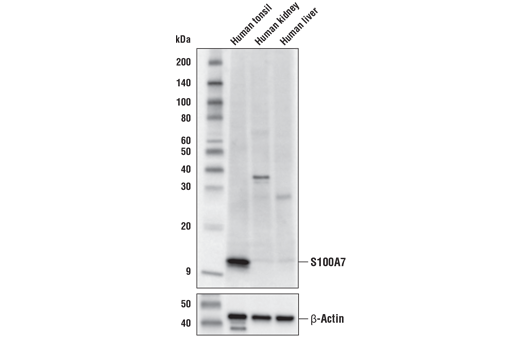WB
H
Endogenous
11
Rabbit
#P31151
6278
Product Information
Product Usage Information
| Application | Dilution |
|---|---|
| Western Blotting | 1:1000 |
Storage
Specificity / Sensitivity
Species Reactivity:
Human
Source / Purification
Polyclonal antibodies are produced by immunizing animals with a synthetic peptide corresponding to residues near the amino terminus of human S100A7 protein. Antibodies are purified by protein A and peptide affinity chromatography.
Background
Despite their relatively small size (8-12 kDa) and uncomplicated architecture, S100 proteins regulate a variety of cellular processes, such as cell growth and motility, cell cycle progression, transcription, and differentiation. To date, 25 members have been identified, including S100A1-S100A18, trichohyalin, filaggrin, repetin, S100P, and S100Z, making it the largest group in the EF-hand, calcium-binding protein family. Interestingly, 14 S100 genes are clustered on human chromosome 1q21, a region of genomic instability. Research studies have demonstrated that significant correlation exists between aberrant S100 protein expression and cancer progression. S100 proteins primarily mediate immune responses in various tissue types but are also involved in neuronal development (1-4).
Each S100 monomer bears two EF-hand motifs and can bind up to two molecules of calcium (or other divalent cation in some instances). Structural evidence shows that S100 proteins form antiparallel homo- or heterodimers that coordinate binding partner proximity in a calcium-dependent (and sometimes calcium-independent) manner. Although structurally and functionally similar, individual members show restricted tissue distribution, are localized in specific cellular compartments, and display unique protein binding partners, which suggests that each plays a specific role in various signaling pathways. In addition to an intracellular role, some S100 proteins have been shown to act as receptors for extracellular ligands or are secreted and exhibit cytokine-like activities (1-4).
S100A7, a member of the S100 family, lacks a calcium binding site in the N-terminal EF-hand domain. It is also known as Psoriasin, due to its involvement of hyperproliferative disorders of the skin (5). Several members of the S100 family have been reported to play a role in tumor progression, angiogenesis, and metastasis (6). S100A7 expression has been shown to be increased in several different types of cancer including lung, breast, skin, head and neck, stomach, ovary, and others (7-10). Overexpression correlates with poor prognosis, and in some tumors promotes metastasis (11,12). The pro-tumorigenic properties of S100 proteins, including S100A7 may make them attractive candidates for therapeutic intervention (13).
- Heizmann, C.W. et al. (2002) Front Biosci 7, d1356-68.
- Donato, R. (2003) Microsc Res Tech 60, 540-51.
- Marenholz, I. et al. (2004) Biochem Biophys Res Commun 322, 1111-22.
- Santamaria-Kisiel, L. et al. (2006) Biochem J 396, 201-14.
- Ekman, A.K. et al. (2017) Acta Derm Venereol 97, 441-8.
- Chen, H. et al. (2014) Am J Cancer Res 4, 89-115.
- Zhang, H. et al. (2007) Lung Cancer 57, 37-45.
- Al-Haddad, S. et al. (1999) Am J Pathol 155, 2057-66.
- Tripathi, S.C. et al. (2010) PLoS One 5, e11939.
- Wang, C. et al. (2019) Pathol Res Pract 215, 127-36.
- Mayama, A. et al. (2018) Cancer Sci 109, 3350-9.
- Lin, M. et al. (2018) DNA Cell Biol 37, 491-500.
- Padilla, L. et al. (2017) Oncogene 36, 6749-61.
Species Reactivity
Species reactivity is determined by testing in at least one approved application (e.g., western blot).
Western Blot Buffer
IMPORTANT: For western blots, incubate membrane with diluted primary antibody in 5% w/v nonfat dry milk, 1X TBS, 0.1% Tween® 20 at 4°C with gentle shaking, overnight.
Applications Key
WB: Western Blotting
Cross-Reactivity Key
H: human M: mouse R: rat Hm: hamster Mk: monkey Vir: virus Mi: mink C: chicken Dm: D. melanogaster X: Xenopus Z: zebrafish B: bovine Dg: dog Pg: pig Sc: S. cerevisiae Ce: C. elegans Hr: horse GP: Guinea Pig Rab: rabbit All: all species expected
Trademarks and Patents
Limited Uses
Except as otherwise expressly agreed in a writing signed by a legally authorized representative of CST, the following terms apply to Products provided by CST, its affiliates or its distributors. Any Customer's terms and conditions that are in addition to, or different from, those contained herein, unless separately accepted in writing by a legally authorized representative of CST, are rejected and are of no force or effect.
Products are labeled with For Research Use Only or a similar labeling statement and have not been approved, cleared, or licensed by the FDA or other regulatory foreign or domestic entity, for any purpose. Customer shall not use any Product for any diagnostic or therapeutic purpose, or otherwise in any manner that conflicts with its labeling statement. Products sold or licensed by CST are provided for Customer as the end-user and solely for research and development uses. Any use of Product for diagnostic, prophylactic or therapeutic purposes, or any purchase of Product for resale (alone or as a component) or other commercial purpose, requires a separate license from CST. Customer shall (a) not sell, license, loan, donate or otherwise transfer or make available any Product to any third party, whether alone or in combination with other materials, or use the Products to manufacture any commercial products, (b) not copy, modify, reverse engineer, decompile, disassemble or otherwise attempt to discover the underlying structure or technology of the Products, or use the Products for the purpose of developing any products or services that would compete with CST products or services, (c) not alter or remove from the Products any trademarks, trade names, logos, patent or copyright notices or markings, (d) use the Products solely in accordance with CST Product Terms of Sale and any applicable documentation, and (e) comply with any license, terms of service or similar agreement with respect to any third party products or services used by Customer in connection with the Products.
